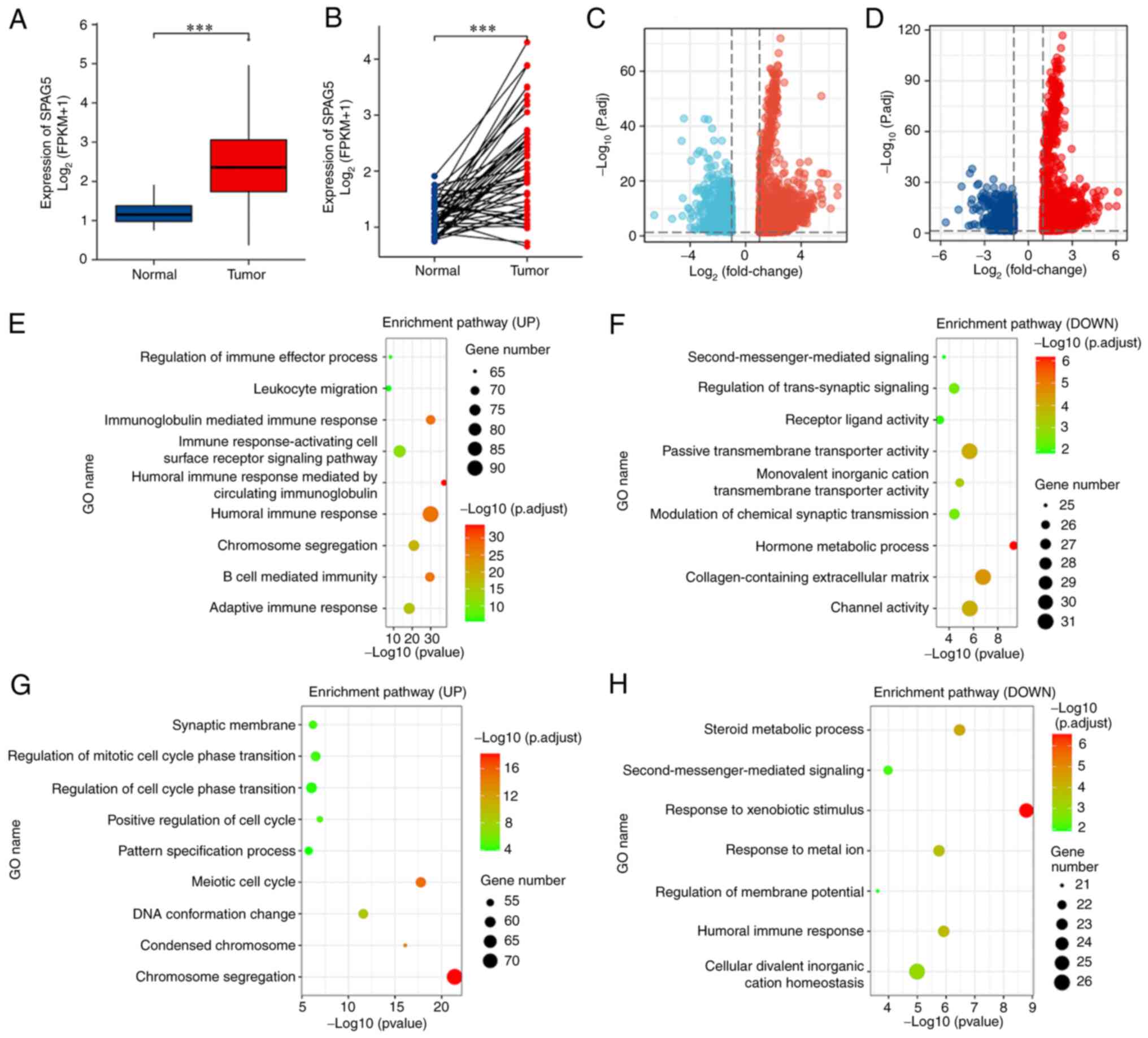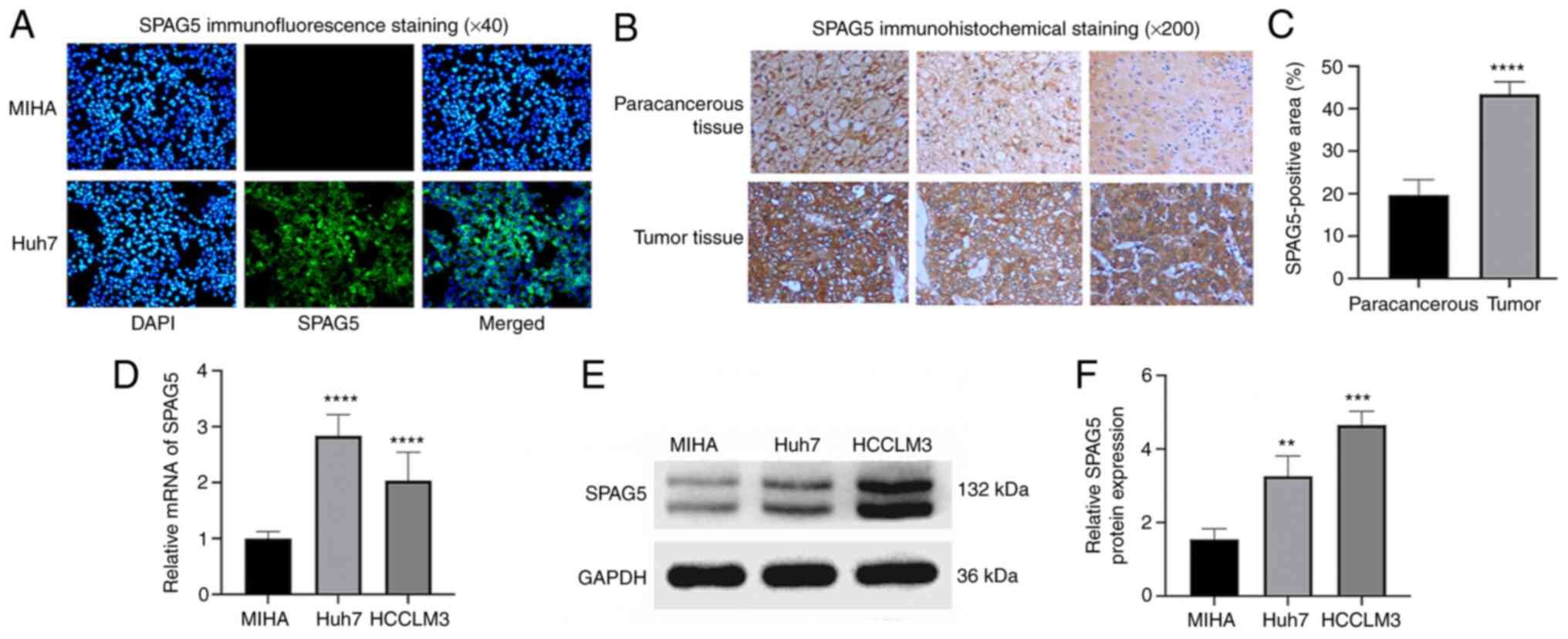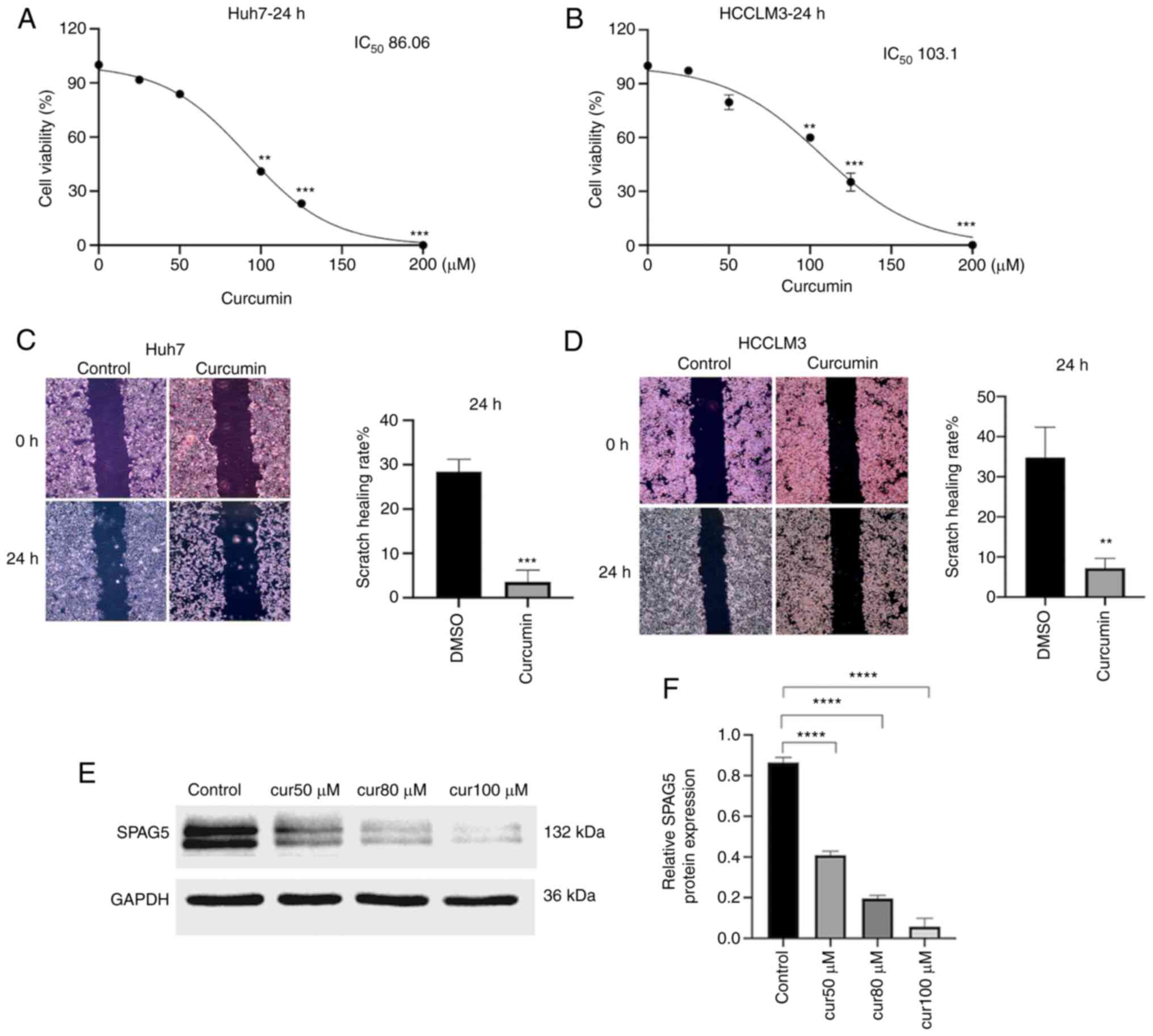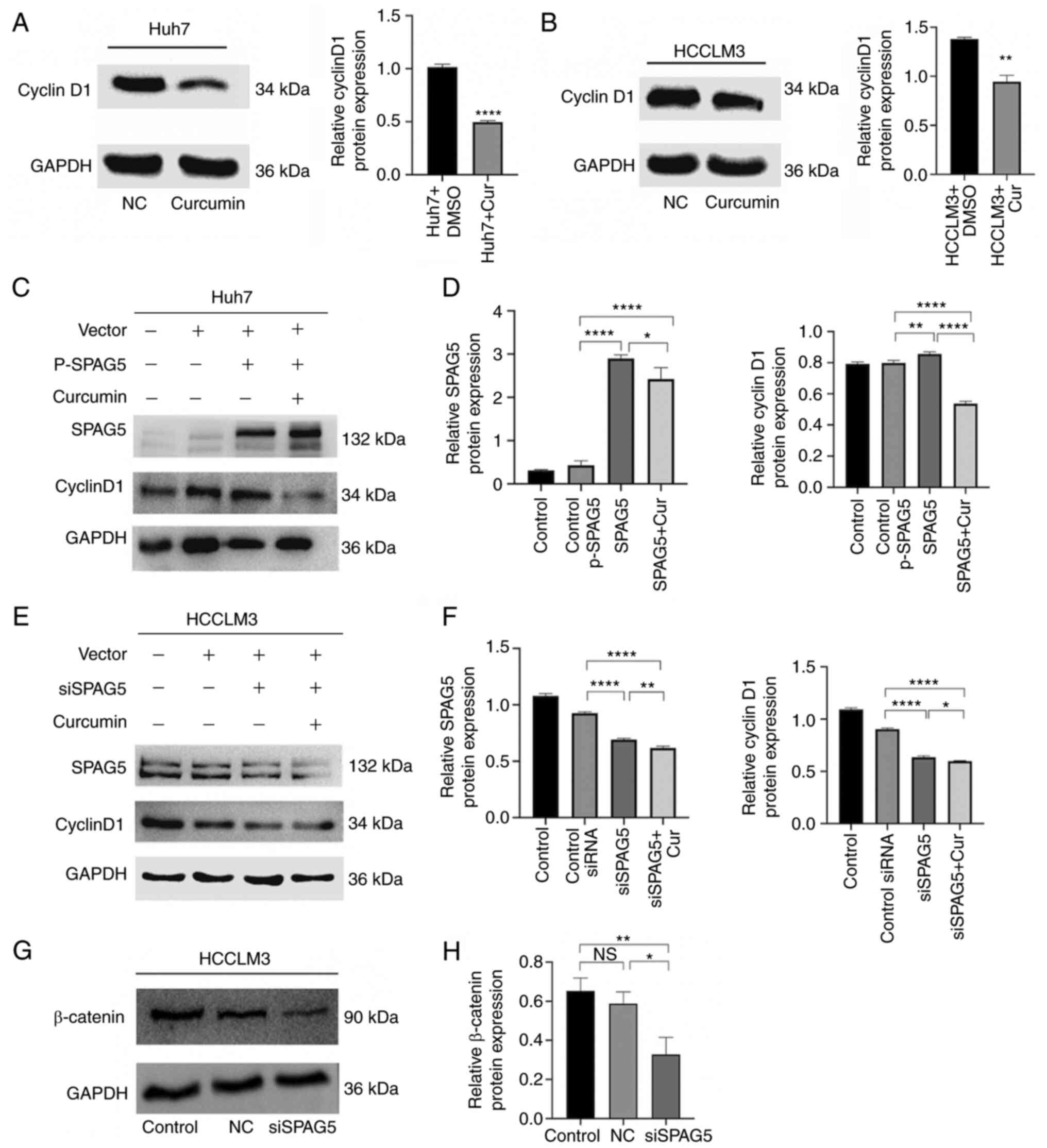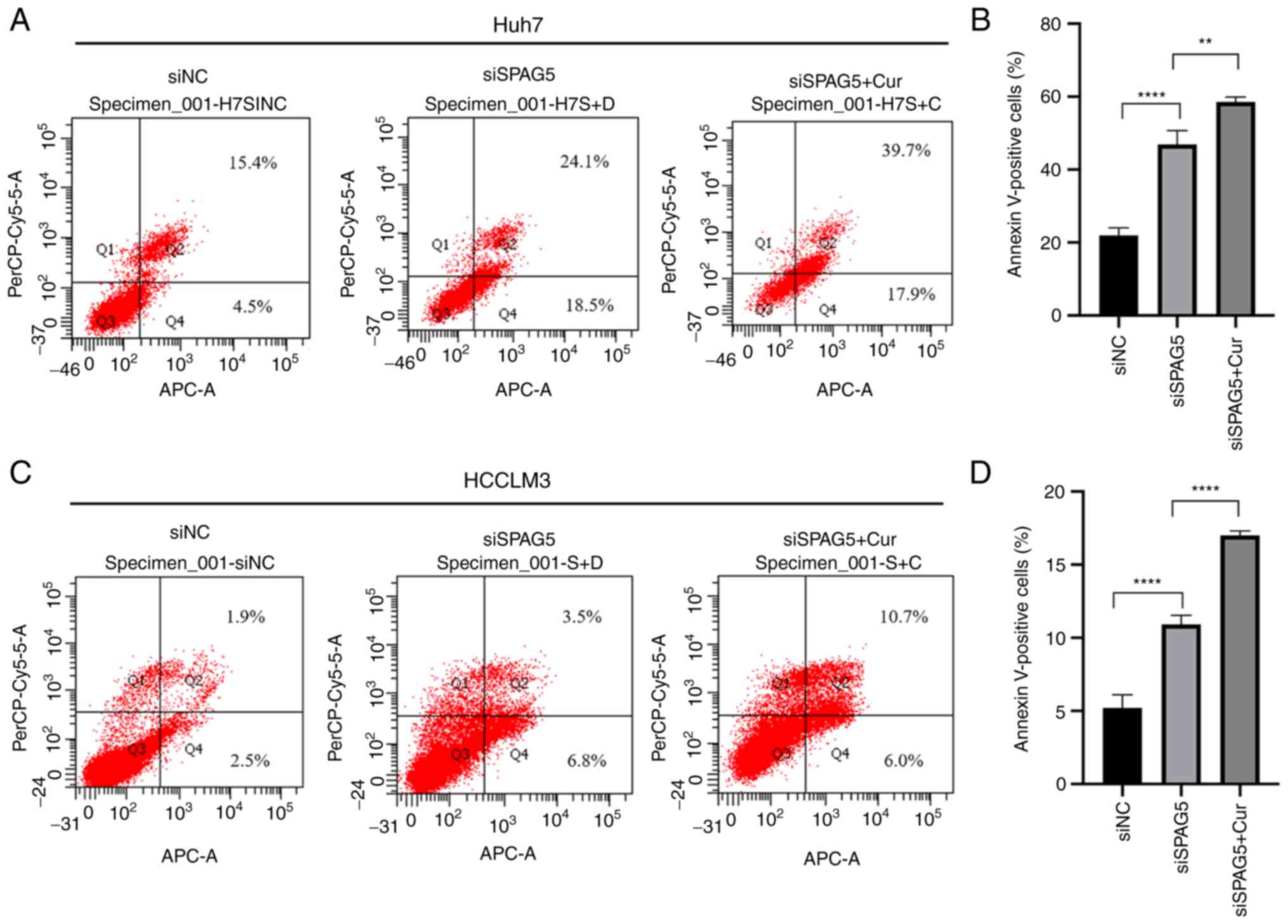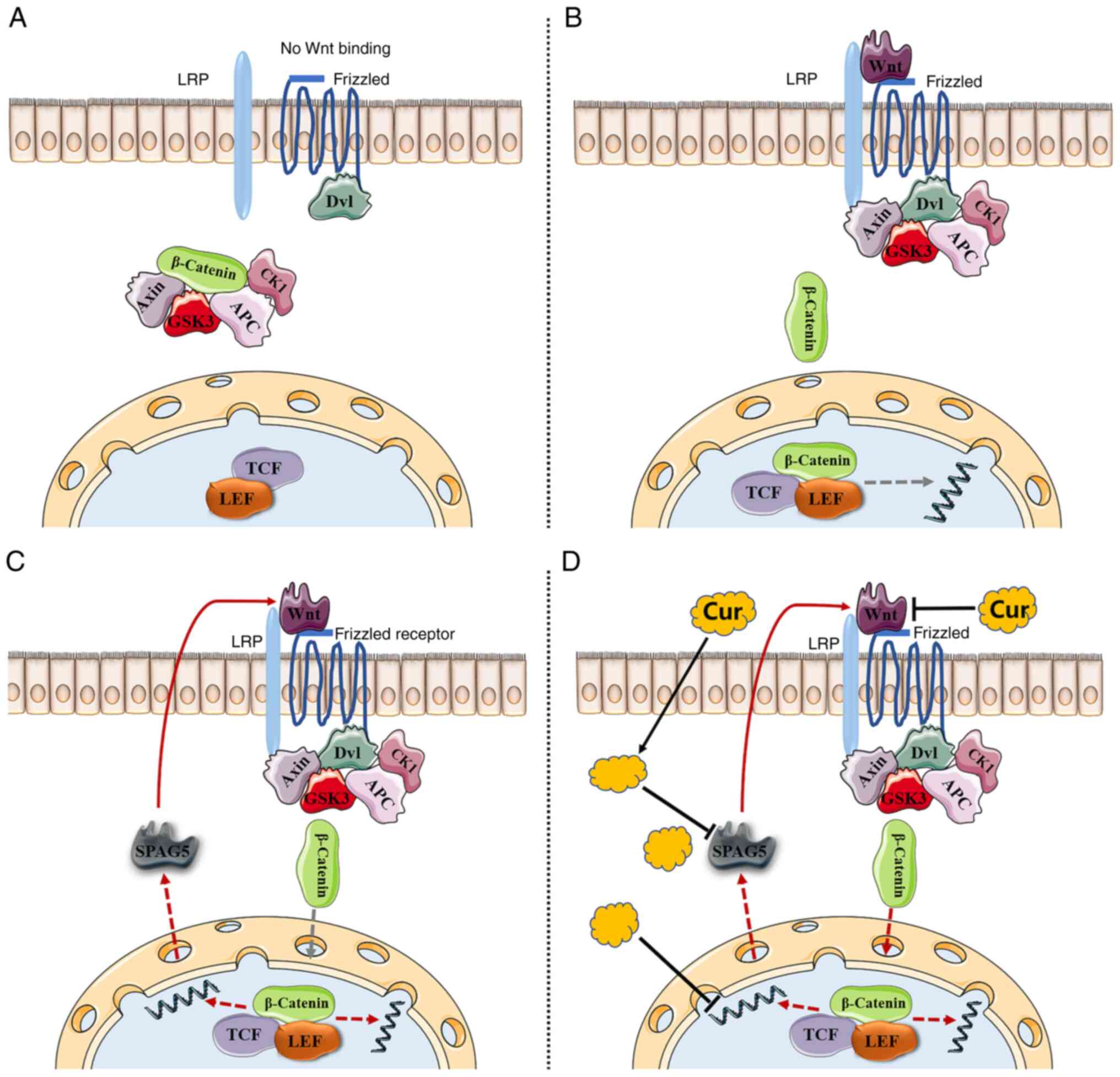SPAG5, the upstream protein of Wnt and the target of curcumin, inhibits hepatocellular carcinoma
- Authors:
- Published online on: August 3, 2023 https://doi.org/10.3892/or.2023.8609
- Article Number: 172
-
Copyright: © Li et al. This is an open access article distributed under the terms of Creative Commons Attribution License.
Abstract
Introduction
Primary liver cancer ranks as the sixth most prevalent cancer globally and the fifth most common malignant tumor in China, where it is also the second leading cause of cancer-related deaths (1,2). Comprising hepatocellular carcinoma (HCC), intrahepatic cholangiocarcinoma, and combined hepatocellular cholangiocarcinoma, primary liver cancer is dominated by HCC, which accounts for 75–85% of cases (1). The development of HCC has been closely linked with viral infections, cirrhosis, alcoholism, smoking, aflatoxin, exposure to harmful chemicals, and genetic factors (2). The disease prevalence significantly varies across the world, reflecting the differing distribution of these pathogenic factors, with 72% of cases occurring in Asia and >50% in China (3). Notably, sex-based disparities exist in the incidence and mortality rates of liver cancer. For instance, liver cancer is the second most lethal form of cancer in men and ranks sixth in women (4). The high mortality rate of liver cancer is primarily due to late diagnosis and a lack of early treatment, necessitating the exploration of new diagnostic and therapeutic approaches. This pursuit, particularly regarding the regulation of the tumor microenvironment and early drug intervention targets, is a promising direction for clinical diagnosis and treatment of liver cancer.
Sperm-associated antigen 5 (SPAG5), a member of the SPAG family, is a spindle-related protein primarily expressed in the testis and placenta that regulates spindle assembly and sister chromatid separation during the M phase of the cell cycle (5). Aberrations in SPAG5 have been implicated in irregular cell cycle regulation and DNA damage, both of which are closely associated with tumorigenesis (6,7). An elevated level of SPAG5 has been documented in numerous tumors (8–12), fostering an interest in its function as a cancer testis antigen (CTA) in cancer genesis, especially its role in promoting cancer via the Wnt/β-catenin pathway. The Wnt/β-catenin pathway is activated in HCC patients, and the function of SPAG5 in HCC has been identified as being mediated through the same pathway (13). In patients with HCC, SPAG5 has been revealed to downregulate the expression of SCARA5 via the β-catenin/TCF4 pathway, thereby exacerbating the progression of the cancer (13). Separate studies by Jiang et al (14) and Liu et al (15) explored the influence of SPAG5 via the Wnt/β-catenin pathway in breast cancer and gastric cancer, respectively. In addition, Rebouissou et al (16) reported that ~95% of patients with HCC exhibited Wnt/β-catenin pathway activation. However, the biological role and clinical significance of SPAG5 in HCC remain unclear.
Wnt is a type of secreted glycoprotein that uses frizzled as its receptor (17,18). The classical Wnt signaling pathway involves β-catenin accumulation and subsequent entry into the nucleus to activate target gene transcription, thus promoting cancer development (19,20). Accordingly, the Wnt pathway has been considered a suitable therapeutic target. Despite this, targeted drugs have faced clinical trial challenges and have not been implemented clinically due to severe side effects (21). As a result, research has shifted towards exploring natural pharmaceutical components capable of inhibiting the Wnt/β-catenin pathway. For instance, genistein has been revealed to inhibit the Wnt/β-catenin pathway and regulate the expression of several Wnt/β-catenin antagonists through epigenetic modifications. Furthermore, myricetin has been demonstrated to reduce cytoplasmic and nuclear β-catenin levels, and curcumin has been observed to limit β-catenin nuclear translocation (22–24).
Curcumin, an active compound extracted from Curcuma longa, exhibits numerous pharmacological effects such as antioxidative, anti-inflammatory, free radical scavenging, and antitumor properties, and is employed in the treatment of cardiovascular diseases and digestive system diseases (25). The antitumor effect of curcumin has been widely researched, revealing a close association with the dysregulation of tumor cell proliferation, apoptosis, and angiogenesis signaling pathways (26). Curcumin, either in isolation or in combination with other drugs, impacts cancer-related signaling pathways (27–28).
There is existing evidence indicating that curcumin can downregulate the Wnt/β-catenin signaling pathway by inhibiting Wnt in HCC, a process partially mediated by the activation of autophagy (29–31). Furthermore, additional research has identified the inhibitory effect of curcumin on tumors associated with the Wnt/β-catenin pathway (32). Notably, it has been established that SPAG5 operates through the Wnt/β-catenin pathway (13). However, to date, no study has explored the curcumin-SPAG5-Wnt/β-catenin triad.
Based on the analysis of bioinformatics databases and previous research (33), the aim of the present study was to combine CTA and SPAG5 with the cancer-related Wnt/β-catenin signaling pathway to explore the regulatory effect of SPAG5 on the Wnt/β-catenin pathway. Confirmation of the hypothesis that curcumin inhibits the Wnt/β-catenin pathway by acting on SPAG5, was also attempted. The goal was to identify alternative methods and new targets for targeted therapeutic drugs aimed at the Wnt pathway, which currently cannot be used clinically due to their side effects. Equally important was the exploration of natural drug ingredients with lower toxicity and side effects for early intervention in HCC, enhancement of the effectiveness of other treatments, and alleviation of drug resistance.
Materials and methods
Gene expression analysis
Differential analysis of SPAG5 expression in cancer tissue compared to adjacent tissue from 374 hepatocellular carcinoma (HCC) patient tissue samples was carried out using The Cancer Genome Atlas (TCGA, http://portal.gdc.cancer.gov/). In addition, Kyoto Encyclopedia of Genes and Genomes (KEGG; http://www.kegg.jp/kegg/kegg1.html) and Gene Ontology (GO http://david.ncifcrf.gov/home.jsp) database used for enrichment analysis. DESeq2 (https://bioconductor.org/packages/release/bioc/html/DESeq2.html) (34) was used to analyze differentially expressed genes, with genes deemed differentially expressed if | log2 FC | ≥1 and P<0.05. Additionally, differential gene expression analysis associated with SPAG5 was conducted.
Patients and sample collection
Tumor tissues from patients with HCC patients, along with corresponding non-tumor tissues, were procured from the Second People's Hospital of Hunan Province (Changsha, China), between March 2021 and December 2022. The clinical and demographic data of participants are outlined in Table I. The inclusion criteria were as follows: i) Age, ≥30 years; ii) patients with HCC who were undergoing surgical treatment; and iii) patients who had previously undergone a physical examination. The exclusion criteria included mental illness and liver and kidney dysfunction. Resected specimens were promptly frozen and stored at −80°C for subsequent analysis. A team of pathologists confirmed the identification of tumor tissues and adjacent normal tissues. Each patient provided written informed consent, and the study was approved (approval no. DK2018002) by the Ethics Committee of the Second People's Hospital of Hunan Province.
Cell culture
The human HCC cell lines (Huh7 and HCCLM3) and a normal human hepatocytes line (MIHA) were procured from the Cell Bank of Type Culture Collection of the Chinese Academy of Sciences (Shanghai, China). These cells were cultivated in DMEM (Dalian Meilun Biology Technology Co., Ltd.) supplemented with 10% fetal bovine serum (FBS; Bioexplorer Life Sciences). The Huh7 cell line, derived from a Japanese male high-grade HCC, is hepatitis B virus-negative and is capable of producing cytoplasmic molecules such as Alb, ATT, and AFP (35). The HCCLM3 cell line, also known as human highly metastatic hepatoma cells, was developed via multiple rounds of in vivo selection in nude mice of the human hepatoma cell line MHCC97-H for its high lung metastatic potential (36). MIHA denotes normal human hepatocytes. The cells were incubated at 37°C in an atmosphere containing 5% CO2.
Plasmid transfection
SPAG5 siRNA plasmid was procured from Shanghai GeneChem Co., Ltd. The process of plasmid transfection commenced with seeding of cells in a six-well plate at a density of 2–3×105 and addition of 2 ml of complete medium. The cells were then placed in a carbon dioxide incubator at 37°C overnight. Transfection reagents were then prepared. Solution A consisted of Opti-MEM (125 µl; Gibco; Thermo Fisher Scientific, Inc.) combined with Lipofectamine®3000 (3.75 µl per well; Invitrogen; Thermo Fisher Scientific, Inc.). Solution B comprised Opti-MEM (125 µl), P3000 (5 µl; Invitrogen; Thermo Fisher Scientific, Inc.), and 2.5 µg of the plasmid to be transfected per well. Solutions A and B were mixed in equal proportions and left to rest at room temperature for 15 min. Upon achieving a cell density of 70–90%, the complete medium was replaced with basal medium. The combined A + B solution was gradually added to each well, mixed gently in a cross direction, and then incubated at 37°C in a carbon dioxide incubator. After 24 h, fluorescence expression was observed with a fluorescence microscope (Olympus Corporation). The sequence for SPAG5 siRNA was as follows: 5′-ccAUGCAACUGGAUUAUACAA-3′. The sequence for the scrambled siRNA was as follows: 5′-UUCUCCGAACGUGUCACGU-3′ (used as the negative control).
Cell Counting Kit-8 (CCK-8) assay
Both Huh7 and HCCLM3 cells were seeded in 96-well plates (Zhejiang Sorfa Life Science Research Co., Ltd.) at a density of 5×104 cells/ml in DMEM medium supplemented with 10% FBS. Following incubation for 24 h at 37°C in an atmosphere containing 5% CO2, the cells were exposed to curcumin at varying concentrations (0, 12.5, 50, 100, 125 and 200 µM). After another 24-h incubation period, 10 µl CCK-8 (Dojindo Laboratories, Inc.) was added to each well and the cells were incubated for an additional 1 h at 37°C. The absorbance at a wavelength of 450 nm was measured for each well using a microplate reader (Thermo Fisher Scientific, Inc.).
Wound-healing assay
Huh7 and HCCLM3 cells were seeded in six-well plates (Zhejiang Sorfa Life Science Research Co., Ltd.) at a density of 2×105 cells/ml and incubated overnight at 37°C. Subsequently, when cell confluence reached 80–90%, a wound was created in the cell layer by manual scraping with a 200-µl pipette tip. The cells were rinsed with PBS (Dalian Meilun Biology Technology Co., Ltd.), then exposed to curcumin in serum-free medium at concentrations of 80 and 100 µM. Images were captured at 0 and 24 h post-wounding to observe the healing process by fluorescence microscopy.
Immunohistochemistry
Tissues were formalin-fixed (fixed in 4% buffered formaldehyde at room temperature for 24 h) and embedded in paraffin. The HCC tissue sections (thickness, 1 µm) underwent treatment with xylene and fractional ethanol, followed by antigen retrieval in 0.01 M citric acid buffer. Blocking was accomplished using 3% hydrogen peroxide (Fuzhou Maixin Biotech Co., Ltd.). Tissue sections were subsequently subjected to a 30-min incubation with 5–10% goat serum (cat. no. SL038; Beijing Solarbio Science & Technology Co., Ltd.) at room temperature, followed by an overnight incubation at 4°C with anti-SPAG5 monoclonal antibody (1:100; cat. no. 14726-1-AP; ProteinTech Group, Inc.). Subsequently, the sections were treated with HRP-conjugated goat anti-rabbit immunoglobulin G for 30 min at room temperature (1:200; cat. no. PR30011; ProteinTech Group, Inc). DAB was utilized for color rendering. Post-staining with hematoxylin (at room temperature for 3–5 min), images of the tissue sections were captured using an Olympus light microscope (Olympus Corporation). Scoring was independently performed by a pathologist (37).
Western blot analysis
Protein extraction of Huh7 and HCCLM3 cell was accomplished using a lysis buffer (Biosharp Life Sciences), followed by quantification using the BCA method. Proteins (50 µg) were separated on 8% SDS-PAGE and transferred onto polyvinylidene fluoride (PVDF) membranes (0.45 µm; Abiowell). The PVDF membranes were then blocked with 5% skim milk for 1.5 h at room temperature. Overnight incubation at 4°C on a shaker followed, with antibodies against SPAG5 (1:20,000; cat. no. 14726-1-AP; ProteinTech Group, Inc.), cyclin D1 (1:20,000; cat. no. ab134175; Abcam), and GAPDH (1:20,000; cat. no. 10494-1-AP; ProteinTech Group, Inc.). Post-0.05% TBST washing, the membranes underwent incubation with goat anti-rabbit IgG-HRP (1:20,000; cat. no. PR30011; ProteinTech Group, Inc.) at 37°C for 1 h. The membrane was visualized using an enhanced chemiluminescence (ECL) detection system (Biosharp Life Sciences). The band grayscale value is calculated using ImageJ (1.53a; National Institutes of Health).
RNA extraction and reverse transcription-quantitative PCR (RT-qPCR)
Total RNA was extracted from Huh7 and HCCLM3 cell using the Ultra-pure total RNA extraction Kit (Simgen Xinjing Biological). The RNA was subsequently reverse transcribed using the PrimeScript RT Reagent Kit (Novoprotein Scientific, Inc.) according to the manufacturer's instructions. For the quantitative polymerase chain reaction (PCR) analysis, qPCR was conducted using SYBR Premix Ex Taq (Novoprotein Scientific, Inc.) as per the manufacturer's instructions. The relative amounts of SPAG5, and GAPDH (internal control) mRNAs were determined using the Real-Time PCR System. The thermocycling conditions were as follows: 95°C for 1 min, followed by 40 cycles at 95°C for 20 sec, and 60°C for 1 min. Relative gene expression was caculated using the 2−ΔΔCq method (38). Primers used for the RT-qPCR assay were as follows: GAPDH forward, 5′-ACAGCCTCAAGATCATCAGC3′ and reverse, 5′-GGTCATGAGTCCTTCCACGAT-3′; SPAG5 forward, 5′-CATCTCACAGTGGGATAACTAATAAAC-3′ and reverse, 5′-CAGGGATAGGTGAAGCAAGGATA-3′.
Cell apoptosis analysis
The apoptosis rate of the cells was assessed using Annexin V-APC/PI Apoptosis Kit (cat. no. E-CK-A117; Elabscience Biotechnology, Inc.) as per the manufacturer's instructions. Briefly, 5×105 cells were harvested by centrifugation at 300 × g for 5 min at room temperature and rinsed twice with PBS. The cells were then resuspended in 500 µl binding buffer and incubated with 5 µl Annexin V-APC and 5 µl PI in the dark at room temperature for 15 min. Apoptotic events were subsequently detected using flow cytometry (BD Fortessa; BD Biosciences) Data analysis was used by FlowJo 10.8.1 (Becton Dickinson and Company).
Statistical analysis
The results, expressed as the mean ± SD, were derived from at least three independent experiments and analyzed using GraphPad Prism 8 (GraphPad Software, Inc.). Significant differences were determined using Student's paired t-test and two-tailed distribution. P<0.05 was considered to indicate a statistically significant difference.
Results
Bioinformatics database analysis of SPAG5 expression and experimental verification in HCC
The expression level of SPAG5 in the tissue of patients with HCC was analyzed via TCGA database. Compared with normal tissues, the tumor tissue of patients with HCC exhibited a significantly higher expression of SPAG5 (Fig. 1A and B; P<0.001). Functional enrichment analysis was carried out on transcriptome data from TCGA. Using the median value of SPAG5 expression as the cutoff point, the upper 50% was designated as the high expression group and the lower 50% as the low expression group. This revealed 14,858 differentially expressed genes, including 2,710 upregulated genes (with top genes being KIF18B, MCM10 and GINS1) and 12,148 downregulated genes (with top genes being SMR3A, MT1B and ANKFN1). DESeq2 was used to analyze differentially expressed genes, with genes deemed differentially expressed if | log2 FC | ≥1 and P<0.05. Applying the same methodology but considering the top 25% as the high expression group and the bottom 25% as the low expression group, 13,213 genes were found to be differentially expressed, including 2,677 upregulated genes (top genes being AL139327, MAGEA4 and LGALS14) and 10,536 downregulated genes (top genes being SMR3A, BX322559 and TRARG1). As indicated in the volcano plot, low expression genes are in blue, and high expression genes are in red (Fig. 1C and D). A series of enrichment analyses, including KEGG and GO, were subsequently performed. The results of GO-KEGG enrichment analysis mainly implicated involvement in the ‘humoral immune response’, ‘immunoglobulin-mediated immune response’, and ‘immune response-activating cell surface receptor signaling pathway’. Additionally, these genes were involved in the regulation of cell division activities, such as ‘chromosome segregation’, ‘regulation of mitotic cell cycle phase transition’, and ‘positive regulation of cell cycle’. Notably, these genes also partook in ‘response to metal ion’, ‘channel activity’, ‘second-messenger-mediated signaling’, and ‘response to xenobiotic stimulus’ (Fig. 1E-H).
Cellular immunofluorescence analysis results showed strong fluorescent expression of SPAG5 in Huh7 cells, while normal human hepatocyte line MIHA displayed no fluorescent expression (Fig. 2A). The expression of SPAG5 in cancer tissues and adjacent tissues from patients with HCC was investigated through immunohistochemical staining. This revealed significantly higher SPAG5 expression in cancer tissues than in adjacent tissues (P<0.001; Fig. 2B and C). To determine the expression of SPAG5 in HCC cells, RT-qPCR experiments were conducted using normal human hepatocyte line MIHA and two hepatocellular carcinoma cells (Huh7 and HCCLM3). The mean fold change of SPAG5 mRNA expression was revealed to be significantly lower in MIHA compared with Huh7 and HCCLM3, with a 2.8-fold increase in Huh7 compared with MIHA cells, and a 2-fold increase in HCCLM3 compared with MIHA cells (Fig. 2D). Western blot analysis was conducted to ascertain SPAG5 protein expression in these cell lines, which also indicated higher SPAG5 expression in HCC cells compared with MIHA (Fig. 2E and F).
Curcumin inhibits the proliferation, migration and SPAG5 expression of HCC cells
CCK-8 results confirmed that treatment of Huh7 and HCCLM3 cells with curcumin for 24 h led to statistically significant differences in cell viability (P<0.05), with optical density (OD) decreasing as curcumin concentration increased. (Fig. 3A and B) The optimal curcumin concentrations for HCC cells, Huh7 and HCCLM3, were determined to be 80 and 100 µM respectively, and these were selected for further experimentation. A scratch test was then performed, with a control group treated with DMSO and an experimental group treated with the optimal concentration of curcumin. The results indicated that after 24 h, the migration ability of curcumin-treated HCC cells was significantly reduced, with the difference being statistically significant (P<0.01 Fig. 3C and D). Western blot results revealed that the expression of SPAG5 protein in Huh7 cells co-cultured with varying concentrations of curcumin was curcumin concentration-dependently inhibited (Fig. 3E and F).
Curcumin inhibits SPAG5-induced cyclin D1 expression, and knockdown of SPAG5 decreases the expression of β-catenin
The expression of cyclin D1 was examined using western blot analysis, and the results demonstrated that the expression of cyclin D1 protein in both cell types was significantly weakened in the curcumin-treated group (Fig. 4A and B). In Huh7 cells overexpressing SPAG5, curcumin could significantly inhibit the expression of SPAG5 and cyclin D1 (Fig. 4C and D). On the other hand, the expression of SPAG5 was significantly reduced in siSPAG5 HCCLM3 cells, and curcumin could further reduce the expression of SPAG5 and cyclin D1, (Fig. 4E and F). In the SPAG5-knockdown cell line, the expression of β-catenin was also significantly decreased (Fig. 4G and H). Although the overexpression of SPAG5 promoted proliferation and migration, curcumin inhibited this promoting effect, but not by inhibiting cyclin D1.
Further investigation was conducted to better understand the mechanism by which SPAG5 contributes to HCC cell growth, specifically examining the effects of SPAG5 knockdown on apoptosis. The findings, as presented in Fig. 5, revealed that the percentage of apoptotic cells was significantly increased in the SPAG5-knockdown group compared with the control group. The application of curcumin resulted in a further increase in the rate of apoptosis. Collectively, these data indicated that the knockdown of SPAG5 exerted a tumor-suppressive effect in human HCC cells, an effect which was amplified by the action of curcumin (Fig. 6).
Discussion
The present study investigated the potential carcinogenic role of SPAG5 in HCC and demonstrated via experimental evidence that the expression of SPAG5 was significantly elevated in HCC at both the tissue and cellular levels. Not only was the high expression of SPAG5 in HCC validated, but also its mechanism and association with Wnt, and the intervention of curcumin were revealed. The present research, exploring uncharted territories, has provided some preliminary conclusions.
Initially, the study revealed that in HCC cell lines, the most suitable concentration of curcumin, which effectively inhibited their proliferation and migration, ranged between 80–100 µM. This inhibition was further confirmed at the gene level by RT-qPCR and at the protein level by western blot analysis. Next, the potential effect of curcumin on SPAG5 was investigated. It was revealed that the expression of SPAG5 in HCC cell lines exhibited a negative association with curcumin concentration. Finally, HCC cell lines overexpressing SPAG5 were co-cultured under the optimal concentration of curcumin, revealing that curcumin could still significantly inhibit the expression of SPAG5 and the Wnt/β-catenin pathway-related oncogene cyclin D1. Moreover, experimental results indicated that curcumin could directly inhibit the expression of β-catenin in HCC cells. Cyclin D1 and β-catenin were inhibited when SPAG5 was knocked down. In addition, when SPAG5 was knocked down, curcumin further inhibited cyclin D1, which indicated that the inhibition of cyclin D1 by curcumin was associated with the inhibition of SPAG5.
The present study elucidated the effect of curcumin on SPAG5 targets in HCC from multiple angles and provided a theoretical basis for the treatment of clinical liver cancer. However, whether curcumin influences normal liver cells, was not addressed during the experimental process of the present study. In addition, these findings are only preliminary conclusions, as additional pathway proteins have not yet been used to corroborate these findings. Whether curcumin directly inhibits Wnt or inhibits Wnt by inhibiting SPAG5 still necessitates further investigation. These questions will be the focus of a future follow-up study.
In summary, the findings of the present study indicated that SPAG5 is a highly significant cancer-promoting molecule and therapeutic target, especially its association with the Wnt pathway, which warrants further investigation. This research could potentially address the issues of drug side effects targeting Wnt. The inhibition of SPAG5 by curcumin also presents a valuable approach for the early intervention and adjuvant treatment of HCC, thus warranting the execution of more clinical trials. While the effect of curcumin has been experimentally confirmed again, the correct application of curcumin in clinical practice requires resolution in the following areas: i) Further elucidation of the mechanism and target of curcumin; ii) addressing the bioavailability of curcumin; and iii) conducting clinical research.
Supplementary Material
Supporting Data
Acknowledgements
Not applicable.
Funding
The Science and Technology Program of Traditional Chinese Medicine of Hunan Province (grant no. 2021033) has provided support for this study.
Availability of data and materials
The data that support the findings of this study are available from the corresponding author upon reasonable request.
Authors' contributions
BR conceived and designed the study. HL performed the experiments and drafted the manuscript. YQ undertook the responsibility of data collection and performed data analysis. The task of gathering and verifying the references was performed by JW, while YH participated in discussing the results. HL and YQ confirm the authenticity of all the raw data. All authors have critically reviewed and edited the manuscript. All authors read and approved the manuscript and agree to be accountable for all aspects of the research in ensuring that the accuracy or integrity of any part of the work are appropriately investigated and resolved.
Ethics approval and consent to participate
The present study was approved (approval no. DK2018002) by the Ethics Committee of the Second People's Hospital of Hunan Province (Changsha, China) and each patient provided written informed consent.
Patient consent for publication
Not applicable.
Competing interests
The authors declare that they have no competing interests.
Glossary
Abbreviations
Abbreviations:
|
SPAG5 |
sperm-associated antigen 5 |
|
HCC |
hepatocellular carcinoma |
|
CTA |
cancer testis antigen |
|
RT-qPCR |
reverse transcription-quantitative PCR |
|
CCK-8 |
Cell Counting Kit-8 |
References
|
Mejia JC and Pasko J: Primary liver cancers: Intrahepatic cholangiocarcinoma and hepatocellular carcinoma. Surg Clin North Am. 100:535–549. 2020. View Article : Google Scholar : PubMed/NCBI | |
|
Chidambaranathan-Reghupaty S, Fisher PB and Sarkar D: Hepatocellular carcinoma (HCC): Epidemiology, etiology and molecular classification. Adv Cancer Res. 149:1–61. 2021. View Article : Google Scholar : PubMed/NCBI | |
|
Shi JF, Cao M, Wang Y, Bai FZ, Lei L, Peng J, Feletto E, Canfell K, Qu C and Chen W: Is it possible to halve the incidence of liver cancer in China by 2050? Int J Cancer. 148:1051–1065. 2021. View Article : Google Scholar : PubMed/NCBI | |
|
Sung H, Ferlay J, Siegel RL, Laversanne M, Soerjomataram I, Jemal A and Bray F: Global cancer statistics 2020: GLOBOCAN estimates of incidence and mortality worldwide for 36 cancers in 185 countries. CA Cancer J Clin. 71:209–249. 2021. View Article : Google Scholar : PubMed/NCBI | |
|
Thein KH, Kleylein-Sohn J, Nigg EA and Gruneberg U: Astrin is required for the maintenance of sister chromatid cohesion and centrosome integrity. J Cell Biol. 178:345–354. 2007. View Article : Google Scholar : PubMed/NCBI | |
|
Buechler S: Low expression of a few genes indicates good prognosis in estrogen receptor positive breast cancer. BMC Cancer. 9:2432009. View Article : Google Scholar : PubMed/NCBI | |
|
Välk K, Vooder T, Kolde R, Reintam MA, Petzold C, Vilo J and Metspalu A: Gene expression profiles of non-small cell lung cancer: Survival prediction and new biomarkers. Oncology. 79:283–292. 2010. View Article : Google Scholar : PubMed/NCBI | |
|
Yang YF, Zhang MF, Tian QH, Fu J, Yang X, Zhang CZ and Yang H: SPAG5 interacts with CEP55 and exerts oncogenic activities via PI3K/AKT pathway in hepatocellular carcinoma. Mol Cancer. 17:1172018. View Article : Google Scholar : PubMed/NCBI | |
|
Zhang H, Li S, Yang X, Qiao B, Zhang Z and Xu Y: miR-539 inhibits prostate cancer progression by directly targeting SPAG5. J Exp Clin Cancer Res. 35:602016. View Article : Google Scholar : PubMed/NCBI | |
|
Li M, Li A, Zhou S, Lv H and Yang W: SPAG5 upregulation contributes to enhanced c-MYC transcriptional activity via interaction with c-MYC binding protein in triple-negative breast cancer. J Hematol Oncol. 12:142019. View Article : Google Scholar : PubMed/NCBI | |
|
Abdel-Fatah TMA, Agarwal D, Liu DX, Russell R, Rueda OM, Liu K, Xu B, Moseley PM, Green AR, Pockley AG, et al: SPAG5 as a prognostic biomarker and chemotherapy sensitivity predictor in breast cancer: A retrospective, integrated genomic, transcriptomic, and protein analysis. Lancet Oncol. 17:1004–1018. 2016. View Article : Google Scholar : PubMed/NCBI | |
|
Yuan LJ, Li JD, Zhang L, Wang JH, Wan T, Zhou Y, Tu H, Yun JP, Luo RZ, Jia WH and Zheng M: SPAG5 upregulation predicts poor prognosis in cervical cancer patients and alters sensitivity to taxol treatment via the mTOR signaling pathway. Cell Death Dis. 5:e12472014. View Article : Google Scholar : PubMed/NCBI | |
|
Liu H, Hu J, Wei R, Zhou L, Pan H, Zhu H, Huang M, Luo J and Xu W: SPAG5 promotes hepatocellular carcinoma progression by downregulating SCARA5 through modifying β-catenin degradation. J Exp Clin Cancer Res. 37:2292018. View Article : Google Scholar : PubMed/NCBI | |
|
Jiang J, Wang J, He X, Ma W, Sun L, Zhou Q, Li M and Yu S: High expression of SPAG5 sustains the malignant growth and invasion of breast cancer cells through the activation of Wnt/β-catenin signalling. Clin Exp Pharmacol Physiol. 46:597–606. 2019. View Article : Google Scholar : PubMed/NCBI | |
|
Liu JY, Zeng QH, Cao PG, Xie D, Yang F, He LY, Dai YB, Li JJ, Liu XM, Zeng HL, et al: SPAG5 promotes proliferation and suppresses apoptosis in bladder urothelial carcinoma by upregulating Wnt3 via activating the AKT/mTOR pathway and predicts poorer survival. Oncogene. 37:3937–3952. 2018. View Article : Google Scholar : PubMed/NCBI | |
|
Rebouissou S, Franconi A, Calderaro J, Letouzé E, Imbeaud S, Pilati C, Nault JC, Couchy G, Laurent A, Balabaud C, et al: Genotype-phenotype correlation of CTNNB1 mutations reveals different ß-catenin activity associated with liver tumor progression. Hepatology. 64:2047–2061. 2016. View Article : Google Scholar : PubMed/NCBI | |
|
Hayat R, Manzoor M and Hussain A: Wnt signaling pathway: A comprehensive review. Cell Biol Int. 46:863–877. 2022. View Article : Google Scholar : PubMed/NCBI | |
|
Clevers H and Nusse R: Wnt/β-catenin signaling and disease. Cell. 149:1192–1205. 2012. View Article : Google Scholar : PubMed/NCBI | |
|
De A: Wnt/Ca2+ signaling pathway: A brief overview. Acta Biochim Biophys Sin (Shanghai). 43:745–756. 2011. View Article : Google Scholar : PubMed/NCBI | |
|
Zhan T, Rindtorff N and Boutros M: Wnt signaling in cancer. Oncogene. 36:1461–1473. 2017. View Article : Google Scholar : PubMed/NCBI | |
|
Kahn M: Can we safely target the WNT pathway? Nat Rev Drug Discov. 13:513–532. 2014. View Article : Google Scholar : PubMed/NCBI | |
|
Duchartre Y, Kim YM and Kahn M: The Wnt signaling pathway in cancer. Crit Rev Oncol Hematol. 99:141–149. 2016. View Article : Google Scholar : PubMed/NCBI | |
|
Steinhart Z and Angers S: Wnt signaling in development and tissue homeostasis. Development. 145:dev1465892018. View Article : Google Scholar : PubMed/NCBI | |
|
Tafrihi M and Nakhaei Sistani R: E-Cadherin/β-Catenin Complex: A target for anticancer and antimetastasis plants/plant-derived compounds. Nutr Cancer. 69:702–722. 2017. View Article : Google Scholar : PubMed/NCBI | |
|
Gupta SC, Patchva S and Aggarwal BB: Therapeutic roles of curcumin: Lessons learned from clinical trials. AAPS J. 15:195–218. 2013. View Article : Google Scholar : PubMed/NCBI | |
|
Udagawa T and Wood M: Tumor-stromal cell interactions and opportunities for therapeutic intervention. Curr Opin Pharmacol. 10:369–374. 2010. View Article : Google Scholar : PubMed/NCBI | |
|
Al-Ejeh F, Kumar R, Wiegmans A, Lakhani SR, Brown MP and Khanna KK: Harnessing the complexity of DNA-damage response pathways to improve cancer treatment outcomes. Oncogene. 29:6085–6098. 2010. View Article : Google Scholar : PubMed/NCBI | |
|
Jin H, Lian N, Zhang F, Chen L, Chen Q, Lu C, Bian M, Shao J, Wu L and Zheng S: Activation of PPARγ/P53 signaling is required for curcumin to induce hepatic stellate cell senescence. Cell Death Dis. 7:e21892016. View Article : Google Scholar : PubMed/NCBI | |
|
Ashrafizadeh M, Ahmadi Z, Mohamamdinejad R, Yaribeygi H, Serban MC, Orafai HM and Sahebkar A: Curcumin therapeutic modulation of the wnt signaling pathway. Curr Pharm Biotechnol. 21:1006–1015. 2020. View Article : Google Scholar : PubMed/NCBI | |
|
Vallée A, Lecarpentier Y and Vallée JN: Curcumin: A therapeutic strategy in cancers by inhibiting the canonical WNT/β-catenin pathway. J Exp Clin Cancer Res. 38:3232019. View Article : Google Scholar : PubMed/NCBI | |
|
Patel SS, Acharya A, Ray RS, Agrawal R, Raghuwanshi R and Jain P: Cellular and molecular mechanisms of curcumin in prevention and treatment of disease. Crit Rev Food Sci Nutr. 60:887–939. 2020. View Article : Google Scholar : PubMed/NCBI | |
|
Ghasemi F, Shafiee M, Banikazemi Z, Pourhanifeh MH, Khanbabaei H, Shamshirian A, Amiri Moghadam S, ArefNezhad R, Sahebkar A, Avan A and Mirzaei H: Curcumin inhibits NF-kB and Wnt/β-catenin pathways in cervical cancer cells. Pathol Res Pract. 215:1525562019. View Article : Google Scholar : PubMed/NCBI | |
|
Chen W, Chen X, Li S and Ren B: Expression, immune infiltration and clinical significance of SPAG5 in hepatocellular carcinoma: A gene expression-based study. J Gene Med. 22:e31552020. View Article : Google Scholar : PubMed/NCBI | |
|
Love MI, Huber W and Anders S: Moderated estimation of fold change and dispersion for RNA-seq data with DESeq2. Genome Biol. 15:5502014. View Article : Google Scholar : PubMed/NCBI | |
|
Zhou M, Zhao K, Yao Y, Yuan Y, Pei R, Wang Y, Chen J, Hu X, Zhou Y, Chen X and Wu C: Productive HBV infection of well-differentiated, hNTCP-expressing human hepatoma-derived (Huh7) cells. Virol Sin. 32:465–475. 2017. View Article : Google Scholar : PubMed/NCBI | |
|
Li B, Zhang Y, Wu W, Du G, Cai L, Shi H and Chen S: Neovascularization of hepatocellular carcinoma in a nude mouse orthotopic liver cancer model: A morphological study using X-ray in-line phase-contrast imaging. BMC Cancer. 17:732017. View Article : Google Scholar : PubMed/NCBI | |
|
Ram S, Vizcarra P, Whalen P, Deng S, Painter CL, Jackson-Fisher A, Pirie-Shepherd S, Xia X and Powell EL: Pixelwise H-score: A novel digital image analysis-based metric to quantify membrane biomarker expression from immunohistochemistry images. PLoS One. 16:e02456382021. View Article : Google Scholar : PubMed/NCBI | |
|
Livak KJ and Schmittgen TD: Analysis of relative gene expression data using real-time quantitative PCR and the 2(−Delta Delta C(T)) Method. Methods. 25:402–408. 2001. View Article : Google Scholar : PubMed/NCBI |



